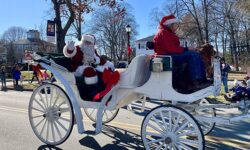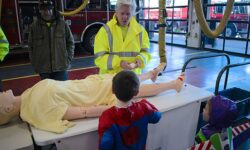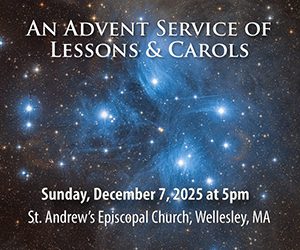By Stephen Press
Hometown Weekly Editor
For as long as I can remember, Walpole’s been a sports town.
From the Porkers’ perpetual excellence to local Little Leaguers streaking towards Williamsport to the grit and skill of current Bruin Chris Wagner, this is a community that properly celebrates the athletic achievements of its own.
Which is why, when I found myself staring at a yellowed, old baseball card featuring a Walpole resident whose existence had been a mystery to me until moments before, I was a bit flummoxed. How could this be so?
Let me introduce you to William “Roscoe” Coughlin, a professional baseball player born in Walpole in 1868. Coughlin, a pitcher, found himself bouncing around in regional baseball leagues by the time he was 19. He was successful at it, too, posting sub-3 ERAs over 300 innings spent between the Lynn Lions of the New England League, Albany Governors of the International Association, and Chicago Maroons of the Western Association between 1887-1888. He would then move to the west coast, where he took his talents to the California League.
By 1890, his success in the minors had been sufficient to earn him an opportunity with the Chicago Colts - today the Chicago Cubs - of the National League. Coughlin, it seems, was something of a spot-starter for the club; his 10 games started (and 10 complete games) were good for fifth-best on the team. For perspective, the Cubs’ ace that year, Bill Hutchinson, started a whopping 66 games (65 CG) and threw 603 innings; to say the least, pitch counts were not yet of concern to managers.
The 22 year-old greenhorn Coughlin pitched respectably during his time in Chicago, putting up a 4-6 record to go along with a 4.26 ERA over 95 innings. He also showed a bit of skill with the bat, collecting 10 hits (including a double and triple) over 39 at-bats. For those of you interested in advanced statistics, his WAR (wins above replacement) was .4 on the year, effectively telling us that his contribution to the team, while minor, was nonetheless greater than average.
His time with the Colts also saw him share a dugout with a certifiable baseball legend: Cap Anson, who was arguably the game’s first true superstar. (Anson, it should also be noted, was a virulent racist whose refusal to take the field alongside black players effectively led to baseball’s shameful color barrier).
Despite his youth and relative success in his first National League season, Coughlin would find himself back in the minors by the beginning of 1891, where he dominated as the ace of the Syracuse Stars of the Eastern Association. Between a 28-12 record and 1.05 ERA over 367.1 innings, the 23-year-old would soon punch his ticket back to the bigs, this time with the New York Giants.
He appears to have been used as a spot-starter for the club, just as he had the year before in Chicago; he started seven games (6 CG), posting an ERA of 3.84 over 61 innings. Coughlin continued to rub elbows with more stars, too. The 1891 Giants boasted six eventual Hall-of-Famers: first-baseman Roger Connor, catcher Buck Ewing, pitcher Tim Keefe, outfielder Jim O’Rourke, pitcher Amos Rusie, and pitcher Mickey Welch - names that make a baseball scholar’s jaw drop.
Coughlin’s career in the bigs would be finished after that season with the Giants, and his career in the minors would end years later in 1897. Soon after, he would join the military and participate in the Spanish-American War - evidently, Coughlin was admirable for his patriotism, as well as his arm. He would later return to Massachusetts, where he died at the Old Soldiers Home in Chelsea in 1951.
My chance to sit down with Roscoe Coughlin is sadly long passed. In reality, it never existed; our respective lives never overlapped. Consequently, the questions I have for him will remain unanswered.
Did you ever throw to Buck Ewing, and was his arm as good as his contemporaries made it out to be? (The legendary catcher was said to have such a cannon that the 1938 “Spalding Guide” reported: “He handed the ball to the second baseman from the batter’s box”).
How sharp did Cy Young’s stuff look in person? (Young and Coughlin both entered the National League in the same year, 1890).
Who talked the most trash on the field, and how “trashy” was it? (In the early days, baseball was seen as a game for profane, unrefined roughnecks; surely, Coughlin heard some rich chirping from his colleagues, likely even from some now enshrined in Cooperstown).
As for that old baseball card? I’d hoped to buy it and donate it to the Walpole Historical Society - it would have made for an excellent jumping-off point for a story, I thought.
That it surely would have.
That card featuring Roscoe Coughlin of the Chicago Maroons, the only known example in existence, is currently selling for $100,000, marked down from $125,000.
And so, while I haven’t the pleasure of presenting the town with an 1887 Old Judge Cigarettes baseball card featuring its native son, I do have the privilege of reintroducing Roscoe Coughlin to his neighbors, over 150 years after his birth.
Walpole has always been a sports town, all right - and for a lot further back than my own memory can take me.
























